Presidents Emeriti
Listed below are the past presidents of Ohio University
-
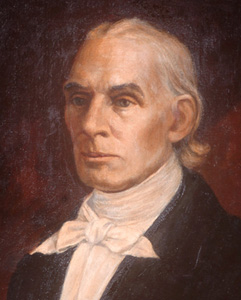
Born in Pennsylvania and educated at Jefferson College and the College of New Jersey, Dr. Lindley came to the presidency at the age of 35 from the pastorate of the Presbyterian Church of neighboring Waterford, Ohio. His was the task of organizing the academy (a preparatory school) and college, implementing a classical curriculum. He also taught the classes, which he did without assistance until 1814.
Classes, first organized in 1809, met in the two-room academy building which had been completed in 1808. The University was one of the first "Land Grant Colleges," receiving two townships in the County as university lands which were leased instead of sold, the rents serving as funds for the college. Originally to be known as American Western University the name was quickly changed to The Ohio University. The rules adopted for the University were those of the College of New Jersey (Princeton) "in so far as applicable." Literary societies were established. The first two baccalaureate degrees were conferred in 1815. Thomas Ewing, later holder of prominent positions as U.S. Senator and two Cabinet posts, was the first graduate. The College Edifice (Cutler Hall) was begun in 1816 and occupied in 1818. A four-year program of college courses was adopted in 1819.
Dr. Lindley asked to be relieved from the presidency but remain churchmaster in 1820. He continued in the ministry after retirement.
-

After extensive searches, no portrait or signature of Irvine has ever been found.
Native of New York and educated at Union College, Professor Irvine moved to the presidency from his professorship of mathematics at the University which he had assumed the previous year. He had been on his way to a position in Kentucky when, passing through Athens, he was asked to take a position at the University. Only a year into his tenure he took a leave on account of ill health. He was presiding when Rufus Putnam, one of the founders of the University, donated a valuable collection of books and it was decided admonition of students for disciplinary problems was not working so fines, not to exceed five dollars, were instituted. In 1823 the Trustees recommended the establishment of a medical college and a botanical garden: the former had to wait over 150 years and the latter no longer exists. Irvine never returned, finally resigning the presidency in 1824.
He continued in the ministry following retirement only reaching 43 by the time he died. (No portrait or signature is known to exist of Irvine.)
-

Native of North Carolina and educated at Dickinson College, Dr. Wilson (who had been a trustee since 1809) came to the presidency at age 56 from the pastorate of the Chillicothe Presbyterian Church and teaching in the Chillicothe Academy. Progress during his term was considerable, with a department of English studies being added to the curriculum to provide teachers for the common schools and to qualify men for business careers. In 1825 the first masters degree was awarded Thomas Ewing, the University's first graduate. John Newton Templeton, was the first African-American graduated from the University in 1828, and the sixth in the nation. The University's first riot occurred in 1835 over a pledge requiring students to report disorderly compatriots. A summer session was offered in 1836 which included 33 college students. East Wing and West Wing (Wilson and McGuffey Halls) were completed in 1837 and 1839. In 1838 a fence was erected well up on the green near the college buildings to keep out wandering pigs. That same year saw the beginning of a program of free admittance of one indigent student from each Ohio county and the continuation of a concentration in teacher training for public schools. Revenue was enhanced through sales of lands in fee simple by authority of the state legislature.
Dr. Wilson continued in the ministry after retirement.
-
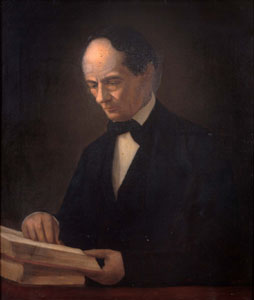
Native of Pennsylvania and educated at Washington College, Dr. McGuffey came to the presidency at age 38 from the same position at the Cincinnati College, where he had gone from a professorship at Miami University. The original Academy building (located behind the present Galbreath Chapel) was torn down in 1841. The Hocking Canal reached Athens in 1843 making travel easier and the "McGuffey Elms" on the College Green were planted. The expanded physical plant and faculty, and the proliferation of studies to include such subjects as music and drawing contributed to increasing financial problems. Additional problems, stemming from disagreements between McGuffey and the University community, included an extreme drop in staff and students. Problems at the University reached a climax in 1843 when the state legislature forbade the revaluation of rents for University lands. As a result President McGuffey resigned and assumed a position at Cincinnati's Woodward high school and then moved to a professorship at the University of Virginia.
The first two editions of the McGuffey Readers, for which he is famous, were copyright before his term as President of Ohio University; his work on the Readers continued through and after his term as President.
-
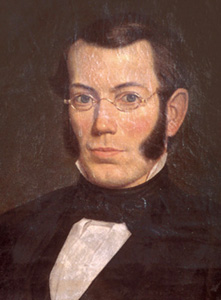
Native of Pennsylvania and educated at Jefferson College, Dr. Ryors came to the presidency at age 36 from a professorship at Indiana University. He had been professor of mathematics at The Ohio University under presidents Wilson and McGuffey. He then took the same position at Indiana University from 1843 through 1848. Ryors returned and assumed the presidency after financial conditions had forced a suspension of college activities for three years while the Academy continued. He succeeded in reducing indebtedness and restoring confidence in the institution's future.
The first general meeting of alumni was held in connection with commencement in 1849. In early 1850 a student attempted to set fire to Cutler Hall; he was expelled the following year. Also in 1850, a scholarship selling scheme was initiated and the first class was graduated since the University had closed five years before.
Upon his retirement Dr. Ryors returned to Indiana to serve in the ministry and to become president of Indiana University and later Centre College in Danville, Kentucky.
-

Native of Ohio and educated at Miami University and Augusta College in southern Ohio, Solomon Howard came to the presidency at age 41 from the same position at the Springfield Female Academy of the Ohio Methodist Conference. He was a Methodist minister who had been active in the founding of Ohio Wesleyan University. With Howard's election domination of University affairs passed from the Presbyterians to the Methodists.
A scientific course of study for those interested in teaching or business pursuits was added to the curriculum in 1853. That same year the Southeast Ohio Teachers' Institute was established by the University and Marietta College, and the Trustees again attempted to realize medical and law schools. The following year the indigent students program was made obligatory by the General Assembly and Athens voted to outlaw the sale of liquor. In 1856 students and visitors to the University could come by railroad for the first time. The following year a doctor of letters degree was awarded to Thomas Ewing. In 1858 the University was free of debt. The Southeastern Normal Institute (teacher training) was founded, formalizing the summer classes begun in 1853. The Civil War brought a severe decline in students even though the Trustees acted to accept wounded veterans tuition-free in 1863. In 1867 the University became a member of the Ohio College Association. A female (Margaret Boyd) entered the University for the first time in 1870. She and other women were accepted through Trustee action the following year.
Death followed by a year Dr. Howard's retirement to San Jose, California, which had been prompted by ill health.
-

Native of Athens County and educated at Ohio University, Dr. Scott came to the presidency at age 32 from his professorship of philosophy at the University, the first alumnus to attain the presidency. He was an ordained Methodist minister. Active in seeking direct financial support from the state legislature, he obtained funds to refurbish the buildings, to build a chapel building, and to improve the grounds. The first state funds were used to repair Cutler Hall. During his term a teacher training course was introduced, a degree was awarded a woman for the first time, and a woman faculty member (Miss Cynthia Weld) was employed in 1882.
The University's rival to the North, originally named the Ohio Agricultural and Mechanical College (now O.S.U.) opened in 1873 just after Miami University closed down for twelve years and the whole Hocking valley suffered a terrible flood. In 1879 the libraries of the Literary Society and the College were merged into a central library. In 1880 President Scott began a campaign to have Ohio, Miami, and Ohio State universities combined. In 1883 he resigned and was named president of Ohio State University.
-

Native of Pennsylvania and educated at Dickinson College, Tuebingen University (Germany), Illinois Wesleyan, and Syracuse, Dr. Super came to the presidency at age 41 from his professorship of Greek at the University. In 1885 the first annual appropriation of money was received from the state legislature and the first African-American, John R. Blackburn, joined the Board of Trustees. In 1886 a normal department (teacher training) was established with state support. The first course in pedagogics was introduced in 1888, and in 1890 the athletic field was purchased (now the site of Walter Hall and Bicentennial Park, for many years this was the site of the Trautwein Field baseball park). Faculty members instituted private summer sessions in 1892. In 1893 the Civil War Monument on the green was completed. The first college choir was organized in 1894-95. The first known international student, Saki Taro Murayama of Japan, graduated in 1895. The commercial course was instituted to meet the increasing demands of the business world for college-trained people. Between his two terms Dr. Super continued teaching and traveled in Europe. With income sources more promising and the new Ewing Hall providing major new facilities and amenities, prospects for the future were positive. To make room for Ewing Hall, the Chapel Building was moved to behind Cutler Hall and turned into a library. By 1900 there were at least 30 women attending the University.
Following his resignation, Dr. Super became professor of Greek and Dean of the College of Liberal Arts, positions from which he resigned in 1907. He continued his residence in Athens following his retirement.
-
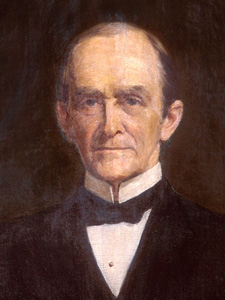
Native of Ohio and educated at Ohio Wesleyan University, Dr. Crook came to the presidency at age 63 from the chancellorship of Nebraska Wesleyan University and before that the presidency of the University of the Pacific. He was a Methodist minister noted for his skills as a teacher, lecturer, and writer. He was active in the recruitment of students by making numerous promotional trips. Dr. Crook placed great emphasis on library acquisitions including the addition of fifty volumes from the "Coonskin Library." An enhancement of faculty rights came with the fourteen department heads combining as a Faculty Senate. In 1896-97 the Ohio University Mirror (first campus newspaper) was established. Crook's administration, however, was so noted for the disharmony between faculty and administration that he lost the confidence of the Trustees and the Athens newspaper and acceded to calls for his resignation after only two years in the office.
-

Native of Kentucky and educated at Washington and Lee and Miami universities, Dr. Ellis came to the presidency at age 54 from the same office at the State Agricultural College at Fort Collins, Colorado. A nationally recognized leader in public school education and administration, his term saw an impressive advance in physical plant, with a dozen buildings being added, including Ellis Hall which was built to accommodate the new State Normal School. Schools of Commerce and Oratory were opened. Summer school was made a part of the regular University offerings in 1902 and the offices of alumni director and dean of women were established. The Carnegie Library (current Scripps Hall) was built in 1904 and the departments of Civil and Mining Engineering were added. In 1906 Miami and Ohio universities were prohibited by the Eagleson Bill to offer technical or graduate instruction beyond a master of arts. Squirrels were specially introduced on the campus in 1908. The campus newspaper changes its name in 1911 to the Green and White. College preparatory programs, which had existed from the beginning, were transferred from Gordy Hall to the University's new John Hancock High School on the top floor of Ellis Hall. In 1913 the University changed to a two semester academic year and was accredited by the North Central Association, becoming one of the Association's charter members. The first African-American female graduate was Martha Blackburn in 1916. World War I brought Army training to the campus and the flu epidemic caused all women students to be sent home for six weeks.
Dr. Ellis died in office.
-

Born in Ohio and reared in Indiana, Dr. Bryan was educated at Indiana, Harvard, and Clark universities. He came to the presidency from the same position at Colgate University. With teacher preparation the dominant program, resulting in women students outnumbered men by a large margin, arts and preprofessional programs designed to provide a base and balance for a true university, and to attract more men, was promoted. Trustees' life appointments were changed to limited terms in 1921 and the same year the last original tree on the green died. A Men's Union was organized in 1922. The first correspondence courses were offered in 1924. Inter-college athletics were encouraged through construction of a men's gymnasium, a stadium, and joining the Buckeye Intercollegiate Athletic Conference. The addition of Memorial Auditorium in 1929 brought a new sense of unity among students and Chubb Library in 1931 a heightened sense of scholarship. Membership in the Association of American Colleges and Universities was attained, as was recognition of women graduates by the American Association of University Women. A chapter of Phi Beta Kappa was installed.
Dr. Bryan died in office.
-

Educated at the University of Illinois, Chicago, Columbia, and the University of Berlin, Dr. James came to the presidency at age 48 from the same position at the University of South Dakota. With a goal of developing a true university, departments, many of which were duplicated between the existing colleges of Liberal Arts and Education, were regrouped in five colleges. Students entered a degree college after at least one year in the newly created University College which set minimum standards. A graduate college was initiated in 1936, the same year a voluntary ROTC program was established over widespread protests. A Faculty Advisory Council was instituted at the same time. The student newspaper changed its name to the Post in 1939.
Dr. James served during the period which adjustments to economic depression collided with adjustments to a war economy. The first attempt with branch campuses in Portsmouth and Zanesville ran from 1938 to 1941. In the spring of 1943 there was a mass exodus of men headed for World War II. A desire to participate directly in the war effort, coupled with illness that forced curtailment of a leave under State Department auspices, prompted James' resignation. He continued teaching and consulting activities following his resignation.
-
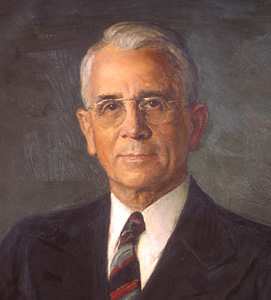
Called to serve on an interim basis, Dr. Gamertsfelder came to the presidency from a dual deanship of the College of Arts and Sciences and the Graduate College. He had been a member of the faculty of philosophy and religion since 1921.
A nation and world at war created serious problems for the University while he served. These included accommodation of faculty leaves for service in the nation's war effort and the initiation of programs for faculty retraining and reassignment as enrollment dwindled to just over two hundred men, and needs for teaching Army Specialized Training Corpsmen and Reservists who were assigned to the campus developed. A memorial service in December 1945 honored 221 alumni who died in the war.
Upon completion of his term, Dr. Gamertsfelder returned to his deanships. Upon reaching the mandatory retirement age for administrators in 1951, he was granted the title Trustee Professor, the first person to be so honored.
-

Educated at Juniata College and Harvard University, John Baker came to the presidency at age 49 from an associate deanship of the Harvard Business School. An advocate of quality in all things human and physical, and with a commitment to public service, he placed emphasis on scholarship and on programs that would foster an international view of humankind and give the University international stature.
Branches, created to accommodate the post-war enrollment surge, became permanent features of the University's regional outreach and the first woman, Evelyn Luchs, was appointed to the Board of Trustees. The extensive Nigerian educational program became a feature of the University's international effort. Dr. Baker's service with the United Nations during his presidency added to this effort.
Faculty rights were strengthened and emphasis placed on research as a basis for effective teaching. Doctor of philosophy degree programs were instituted the first being chemistry in 1956. The Ohio University Fund (now Foundation) was established to foster private giving, and the John C. Baker Fund to support faculty improvement and research efforts. Distinguished Professor awards were initiated. Students were added to committees and a faculty representative sat on the administrative committee. College visiting committees were established. The Cutler Society, a society of intellectually superior students, was formed as one of the many steps in creating a stimulating intellectual climate at the University. Terminal two-year associate in arts degree programs and programs in elective studies were initiated. A successful major scholarship drive was a feature of the University's sesquicentennial celebration in 1954.
Retiring under the provisions of a 65-year age rule he had initiated, Dr. Baker continued to pursue his diverse interests in educational, business, and international affairs until his death in 1999.
-
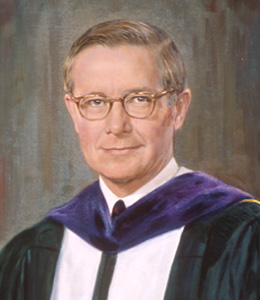
Dr. Alden was educated at Brown and Harvard universities. He came to Ohio University at age 38 from his position of associate dean at the Harvard Business School. His administration saw a doubling of enrollment and faculty, a great expansion of the campus area through urban renewal, and the continuation of a construction program that included a new regional airport. There was a great expansion of research, symbolized by the acquisition of a tandem accelerator, and a broadening of academic and related programs as evidenced by the Honors College, the Cutler Program of Individualized Study, sabbatical leaves, the Ohio University Press, and area studies including funding a Black Studies Institute. There were new endowed chairs, and increased emphasis on voluntary support. Increased rights for faculty and students were evidenced by a Faculty Senate and Student-Faculty Mediation Board. The University assumed an activist role in regional development and expanded its international programs. Significant progress was made in adjusting to the demands of students for participation in governance and for self-regulation of their lives, the demands of minorities for rights and equal opportunity, and the demands by employees for union representation.
Dr. Alden left the University to assume a position with the Boston Company from 1969-1978, has served on several other corporate boards, and has worked extensively in Japan.
-
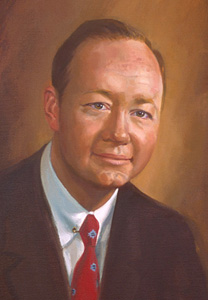
Educated at Northwestern University, Dr. Sowle came to the presidency at age 40 from the deanship of the College of Law of the University of Cincinnati. He served during a period of great stress and change nationwide during the later phase of the Vietnam War and its aftermath, with its accompanying malaise of suspicion and cynicism, conditions that deeply affected the nation's universities. Even the University had to close due to riots during Sowle's first year. An advocate of openness in policy determination and administration, he sought through public forums to enhance understanding and support of higher education locally and throughout the state.
Enrollment and income declines forced critical reviews of programs, with adjustments to offerings and staff. Construction, purchase, and renovation of buildings continued, as did demolition of facilities that had outlived their usefulness. An equal opportunities office was created. A statement of aims for the University and improved accounting methods were developed and approved by the Trustees, as was a statement affirming the University's continued participation in varsity inter-collegiate athletic programs. Long-term leases for commercial development of unused lands were consummated.
Dr. Sowle left Ohio University to assume a professorship of law at Ohio State University and later became dean of the school of law at the University of Miami.
Dr. Sowle died in 1997 in Puerto Rico where he had traveled to inspect a law school for the Accreditation Committee of the American Bar Association.
-
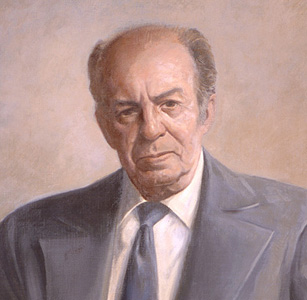
Educated at the College of Wooster and Ohio State University, Dr. Crewson moved to the presidency from his 25 year professorship of economics. He was responsible for the organization of the Ohio University Employees Credit Union in 1955. He also mediated several disputes between the University and its unions as well as the city and its employees, ending or averting strikes. Prior to 1974 Dr. Crewson served as an Athens County Commissioner and had been elected president of the Athens City Council six times during which time he initiated an annual craft fair and saw the voters pass the first city income tax. He was elected by the Trustees to serve for the interim from September 1, 1974, until the Presidential Search Committee's efforts resulted in the election and installment of a permanent president, which occurred exactly one year later. Dr. Crewson brought a deliberate, yet forthright approach to issues. Intensive construction projects continued on the regional campuses. On the Athens campus, where enrollment continued to decline, considerable progress was made on a budget stabilization plan. This effort was aided by reduced tensions and stress nationwide and on campus. In 1975 (after waiting 152 years) Ohio University finally got its medical college, the state's first osteopathic medical school.
Upon completion of his term, Dr. Crewson returned to his department as Trustee Professor of economics, the second person to be so honored with this title.
-

Educated at Rhodes College, Louisville Presbyterian Theological Seminary, and Duke University, Dr. Ping came to the University from the position of provost at Central Michigan University. He had served as acting president of Tusculum College in 1968-1969. Dr. Ping arrived on campus to an institution with great potential but in deep turmoil from a severe decline in enrollment and a critical financial situation. In nineteen years he led the University to its highest enrollment (25,000), a budget of $240 million, an 1804 Fund campaign raised $22.6 million for the University's 175th anniversary, and the Third Century Campaign of 1993 raised over $132 million. A committed believer in general education fundamentals, he did not neglect scholarship, research, and service. The Tier system requires undergraduate students to consider and work with multi- disciplinary approaches, an attempt to synthesize information coming from several areas of study.
Graduate programs were expanded and special focuses were placed with primary research in such areas as avionics, contemporary history, and animal biotechnology. New programs were created such as sports administration, remote sensing, international business, and a new college of health and human services.
The University's international interaction was expanded with additional programs in Africa, Southeast Asia, and Japan and international students on campus topped 1,000. At the same time the University's involvement in its own region included remote teaching via microwave TV, a children's immunization program, and an art museum on wheels.
The main campus more than doubled in size when the former state mental hospital was transferred to the University in 1988. The retention rate of students climbed to nearly 90 percent and the University was ranked as one of America's best higher education buys. Numerous state academic and program excellence awards were earned, a new aquatic center was built, and construction was begun on a new recreation center.
Upon his retirement as president Dr. Ping took a year's sabbatical before returning to teach and direct the Ping Institute for the Teaching of the Humanities.
-
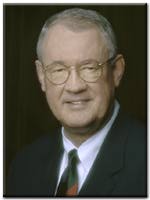
During his ten-year presidency, Dr. Robert Glidden embraced improvements in technology, aggressively encouraged faculty research, supported major changes to the academic curriculum, and spearheaded the University's Bicentennial Campaign that raised over $221 million for scholarships, endowed professorships, technological enhancements, and innovative programs. Capital improvements under Glidden included the construction of the Life Sciences Research Facility, Emeriti Park, and Walter Hall, a modern classroom lecture center; major renovations to Gordy Hall, Grover Center, and Memorial Auditorium; the expansion of Bentley Hall and Copeland Hall; and groundbreaking for a new student center that opened in 2007.
President Glidden strongly advocated university service to Appalachia, working with local governments and agencies to undertake technology projects and environmental action. Beyond the region, Glidden served on the Governor's Science and Technology Council in Ohio, and chaired the Ohio Aerospace Institute, the Inter-University Council, and the Mid-American Conference.
President Glidden also chaired of the Commission on Leadership and Institutional Effectiveness for the American Council on Education in Washington. Perhaps Glidden's most enduring contribution to the future of higher education in the United States is his seminal work as the founding chair of the Council on Higher Education Accreditation (CHEA).
Born in Grand Junction, Iowa, Robert Glidden earned his bachelor's degree with distinction in music, his M.A. in music performance, and his Ph.D. in music-all at the University of Iowa. Dr. Glidden served on the music faculties of Wright State University and Indiana University, and from 1969 to 1972 he was associate professor, director of graduate studies in music, and chairman of music education at the University of Oklahoma. He then became the Executive Director of the National Association of Schools of Music and the National Association for Schools of Art in Washington before moving to Bowling Green State University in 1975, where he was a professor and dean of the College of Musical Arts. In 1979, Dr. Glidden became dean of Florida State University's School of Music, and he was appointed provost and vice president for academic affairs at FSU in 1991.
In his retirement, President Emeritus Glidden remains active in the business of higher education, as he continues to consult with universities at home and abroad, and he maintains his leadership in the field of university accreditation. Glidden also remains involved with Ohio University, having committed three years of part time work toward raising funds for a new alumni center.
-
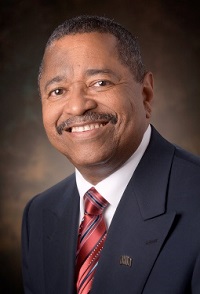
Dr. Roderick J. McDavis began his academic career at Ohio University in 1966, where he participated on the men's varsity track team and was a member of Omega Psi Phi fraternity. Following completion of his undergraduate education in social sciences in secondary education, Dr. McDavis earned his master's degree in student personnel administration from the University of Dayton in 1971. He pursued his doctoral degree in counselor education and higher education administration from the University of Toledo.
Upon the receipt of his Ph.D. in 1974, Dr. McDavis embarked on a progressive and broad career in higher education, which included various academic and administrative roles at the University of Florida, the University of Arkansas and Virginia Commonwealth University. All of these experiences prepared Dr. McDavis to attain his lifelong dream of serving as a college president. He achieved this goal when he assumed the presidency of Ohio University on July 1, 2004.
As the university’s first African American president and only the second alumnus to lead the Ohio University in the institution’s 211-year history, Dr. McDavis has been a tireless ambassador. His contributions to higher education include assisting in the development of the state of Ohio’s technology commercialization implementation plan, the state’s first guaranteed tuition plan, and one of the first of its kind performance-based funding models in the nation. As president, he developed and implemented Ohio University’s comprehensive strategic plan and was instrumental in the success of The Promise Lives Campaign, which raised over half a billion dollars in support of students and programs, $50 million more than its fundraising goal. The Urban Scholar and Appalachian Scholar programs, The Interlink Alliance partnership, and Ohio University’s commitment to climate neutrality are among the many initiatives that came about as a result of his leadership.
Throughout his distinguished career, Dr. McDavis has been the recipient of numerous prestigious honors and awards. This includes the University of Arkansas’ Silas Hunt Legacy Award, which recognizes African Americans for significant achievements or contributions to the community, the state, and the nation. In 2007, Dr. McDavis was one of only six president and CEO-level leaders in the state to be recognized with a Leadership Ohio Award of Excellence. He also was inducted into the Association of Ohio Commodores in 2010. Other notable awards include the Post-Secondary Outstanding Educator Award from the North Central Florida Chapter of Phi Delta Kappa (1996), the Black Achiever’s Award in Education from the Florida Conference of Black State Legislators (1997), and Person of the Year in Education by The Gainesville Sun (1995).
Through service on numerous boards and associations, Dr. McDavis dilligently sought to further Ohio University’s state and national leadership. This included his time serving with the National Collegiate Athletic Association (NCAA) Board of Governors, the NCAA Division 1 Board of Directors and the Ohio Third Frontier Advisory Board. He also chaired The Interlink Alliance and the NCAA Division 1 Committee on Academics. His service included leadership of the Ohio Higher Education Funding Commission 2.0, the Ohio Board of Regents Commercialization Task Force Academia Subcommittee, Ohio's Inter-University Council, the American Council on Education (ACE) Blue Ribbon Panel on Global Engagement, and the Board of Directors of the American Association of Colleges for Teacher Education, among many others.
Dr. McDavis’ passion for education, mentoring, and preparing the next generation of leaders, thinkers, teachers, and entrepreneurs was evident throughout his time leading Ohio University
-
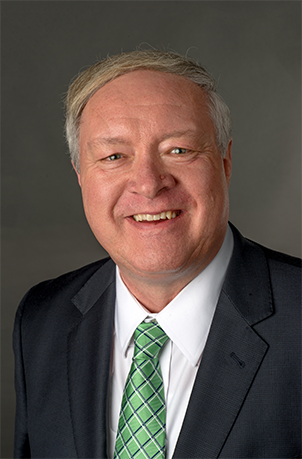
Dr. M. Duane Nellis served as the 21st President of Ohio University from 2017 through 2021. He is currently President Emeritus of Ohio University and Trustee Professor. As an internationally recognized scholar and national higher education leader, Dr. Nellis brought nearly four decades of experience in academia as a president, provost, dean and distinguished professor to Ohio University. As president, he guided Ohio University toward strategic pathways designed to elevate access and inclusion, student success and transformation, research and knowledge discovery in support of vibrant communities, and a sustainable academic enterprise.
During his tenure as president, Dr. Nellis helped lead efforts to reimagine the university’s academic focus by elevating OHIO as a national university while providing the nation’s highest return on experience. This included new efforts such as:
- • The OHIO Admissions Promise
- • The OHIO Guarantee +
- • A new ‘OHIO BRICKS’ General Education curriculum—the first in over 40 years
- • The development of a highly successful OHIO Honors Program—complementing the nationally recognized Honor Tutorial College
- • Strengthening academic engagement and student entrepreneurship (including opening the CO-LAB)
- • Rebranding the University, focusing as the state’s first university through ‘FOREVER OHIO’
- • Elevating the academic health enterprise including a new Academic Health Center (Heritage Hall) and new partnerships with the Cleveland Clinic and OhioHealth
- • Helping create new state-of-the-art learning spaces for students to include the Chemistry Building, Esports Lab, and the new Sook Academic Center
- • Elevating the national and international visibility and success of the Innovation Center
- • Facilitating the development of One OHIO with the regional campuses
- • Revitalization of historically significant spaces, including 29 Park Place and The Ridges.
- • Elevating national rankings of diversity and inclusion efforts (three straight years OHIO received the HEED Award) and the overall ranking of the University (in 2021 Ohio University was ranked as the No. 1 Best Value University in Ohio and 33rd highest in the nation and the No. 1 Online College in Ohio)
- • Starting a US Capital Internship program and the student focused Presidential Leadership Society
- • Leading Ohio University through the global pandemic, arguably one of the most significant challenges higher education has faced in our history.
Prior to arriving at OHIO, Dr. Nellis was president of Texas Tech University. While at Texas Tech, Dr. Nellis was committed to enhancing the University’s presence as a top tier national public research university.
Before he was president of Texas Tech, Dr. Nellis was president of the University of Idaho where he led the university toward record enrollments and record levels of fund raising. Previously, he served as provost and senior vice president at Kansas State University and dean of the Eberly College of Arts and Sciences at West Virginia University, the institution’s largest academic college.
He is recognized nationally and internationally for his research that utilizes satellite data and geographic information systems to analyze various dimensions of the Earth's land surface. This research has been funded by more than 50 sources, such as NASA, the National Geographic Society, the U.S. Agency for International Development, and the U.S. Department of Agriculture. His research has led to more than 160 articles and reports in a wide range of professional journals, and over 20 books and book chapters, and his selection as a Fellow of the prestigious American Association for the Advancement of Science and as a Fellow of the Explorers Club in New York City, among numerous recognitions nationally and internationally. He is past president of the American Association of Geographers.
Most recently, Dr. Nellis served as a member of the executive committee of the Association of Public & Land-Grant Universities Commission on Economic & Community Engagement, on the Executive Committee of the IUC Presidents’ Council (the Ohio public universities inter university consortium), and as an Executive Board member of the Appalachian Partnership, Inc.
Dr. Nellis received his bachelor's degree in earth sciences/geography at Montana State University in 1976. He received his master's and doctoral degrees in geography from Oregon State University in 1977 and 1980, respectively.